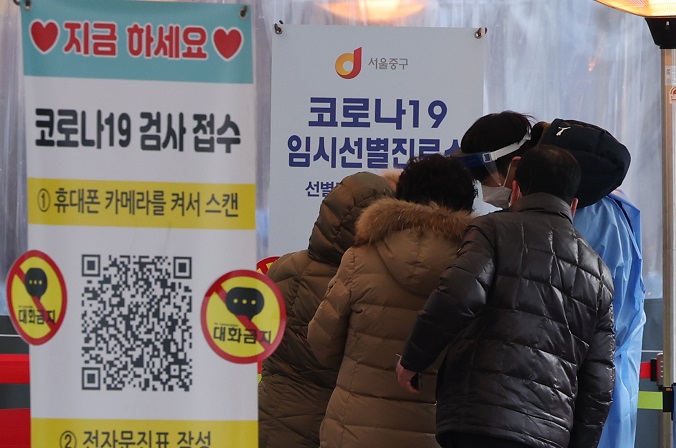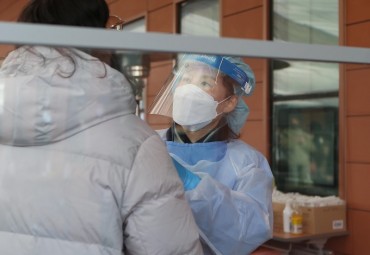
A medical worker guides people standing in line to take coronavirus tests at a screening clinic in front of Seoul City Hall on Jan. 5, 2022. South Korea’s daily coronavirus cases bounced back to above 4,000 for the first time in three days, putting health authorities on high alert over a possible resurgence amid omicron concerns. (Yonhap)
SEOUL, Jan. 6 (Korea Bizwire) — South Korea’s daily coronavirus cases stayed over 4,000 for the second straight day Thursday as the country kept stricter antivirus measures in place amid persistent worries over a resurgence in infections and the spread of the omicron variant.
The country added 4,126 new COVID-19 infections, including 3,931 local infections, raising the total caseload to 653,792, according to the Korea Disease Control and Prevention Agency (KDCA).
This marked the second straight that the daily cases have remained above 4,000 following 4,443 cases tallied the previous day.
South Korea reported 49 more COVID-19 deaths, raising the death toll to 5,887, the KDCA said. The figure was lower than the previous day’s 57 deaths, and the fatality rate was 0.9 percent.
The number of critically ill COVID-19 patients stood at 882, down from the previous day’s 953. Thursday’s figure marked the lowest in 24 days.
The number of critically ill patients has been closely monitored as the country has been grappling with possible shortages of hospital beds for treatment.
As of 9 p.m., the country added 3,296 new COVID-19 cases, down by 183 from the same time the previous day, according to the health authorities and city governments.
The figure marks a drop by 1,053 from the tally registered a week ago, and is down by 2,402 from the same time two weeks earlier.
Daily cases are counted until midnight and announced the following morning.

A medical worker takes a sample from a person at a COVID-19 testing station in Seoul on Jan. 3, 2022. (Yonhap)
South Korea keeps its guard high against the possibility of a resurgence of the coronavirus and deepening worries over the spread of the potentially more transmissible omicron variant.
The government earlier extended the social distancing rules for two weeks through Jan. 16, which include a four-person cap on private gatherings across the nation and a 9 p.m. business hour curfew on cafes and restaurants.
The measure came after the government eased long-enforced antivirus restrictions in early November as part of efforts to return to normalcy in phases under the “living with COVID-19″ scheme.
Daily cases, however, soared to a record high of 7,848 on Dec. 15, prompting the government to reimpose a set of revised virus restrictions for two weeks until Jan. 16.
The extension came as the government remained on alert after the first cases of deaths connected to the omicron variant were reported early this week. Health experts predict omicron will become the dominant variant in South Korea in one or two months.
Of the locally transmitted coronavirus cases reported Thursday, Seoul reported 1,150, while 1,496 came from the surrounding Gyeonggi Province and 273 from Incheon, a port city west of Seoul.
The number of cases from overseas came to 195, raising the total to 18,271.
A total of 42.76 million people, or 83.3 percent of the country’s 52 million population, have been fully vaccinated, and about 19.67 million, or 38.3 percent, have received booster shots, the KDCA said.
Citing the increased booster shot vaccination rate, health authorities said the overall pace of the spread of the virus appears to be slowing down, with the number of critically ill patients also on the decline.
They voiced hope for easing the current level of antivirus restrictions in phases if the current downward trends of infections and severely ill cases continue.
(Yonhap)




![[UPDATE] KAI Inks US$700 Mln Deal To Export FA-50 Aircraft To Manila [UPDATE] KAI Inks US$700 Mln Deal To Export FA-50 Aircraft To Manila](http://koreabizwire.com/wp/wp-content/uploads/2025/06/an-FA-50-fighter-landing-at-an-air-base-in-the-southwestern-city-of-Gwangju.--370x246.jpg)

